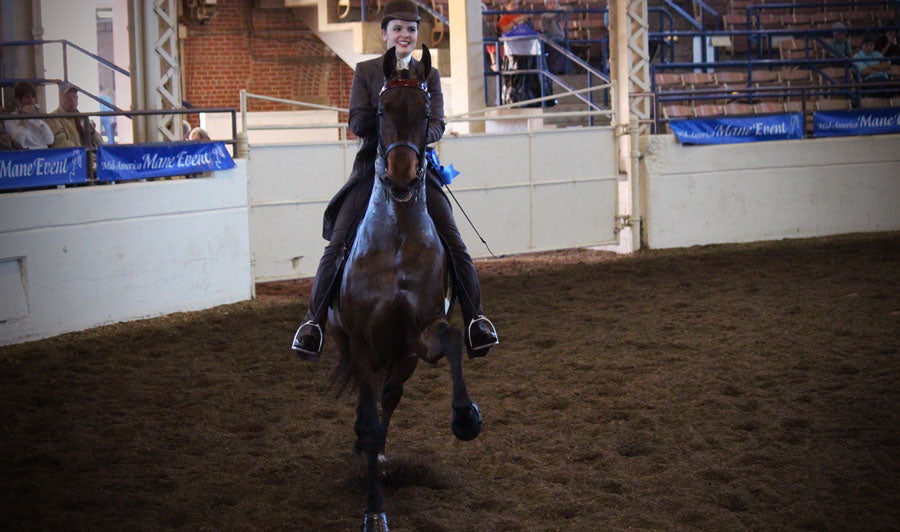The Five Most Common Equitation Mistakes (and How to Avoid Them) March 29 2015 7 Comments

With show season underway, this year’s equitation finals will be STACKED with talent and athleticism. While you are preparing for your age group classes and your qualifying finals classes, keep in mind the most common equitation mistakes that junior exhibitors will make. Avoiding these mistakes won't guarantee you a win, but they'll be sure to set you up for success.
1. Stiffness
Any rider should always be mindful of their form. But when you’re thinking really hard about keeping your legs in position, your eyes up, and a gentle arch in your lower back, you can end up looking like Franken-Rider. Don’t send the villagers scrambling for their torches because you’re riding chin-first with your neck and shoulders so tight that you could be pushed off your mount with one finger. RELAX GUYS!
Being stiff will not help your form, in fact, locking your body into position will make it nearly impossible to keep your form during a fluid canter, or if your horse miss-steps or sees something on the rail that spooks them. Breathe, relax your shoulders down and please do not stick your face out to compensate for keeping your eyes up.
2. No Stirrups = No Form
The number one problem for Senior Equitation competitors is no stirrup work. This will make or break your pattern. Firstly, you have to put in the leg work (harhar) at home. There’s no way you can accomplish a good stretch of no-stirrups in a pattern if you aren’t legged up. Secondly you have to keep your balance in your butt. Often when we are unsure of our ability to ride without stirrups, we tend to get stiff and lean forward, but that will throw you right off the sweet spot of balance on a saddlebred. Keep your shoulders over your hips and think about keeping that post nice and low. Finally, don’t contort your legs super far behind you. As we discussed above, when we ride without stirrups, we tend to get so worried about how our legs look that we’ll contort them too far behind us and jack our ankles out, thinking that our legs look FAB!
They do not.
They look terrible.
Getting your legs too far behind you will also make it harder to for you sit back and down and jacking your ankles out ends up making it look like your toes are pointed down from the perspective of the judges, even if they aren’t.
3. Underestimating Simple Patterns
We’ve all heard an age group championship pattern called out like this: Trot down the rail showing two changes of diagonal, beginning on the right diagonal. Stop. Canter a circle to the left on the left lead. Stop. Reverse and trot down the rail on the left diagonal.
As they ask if anyone has any questions, you relax and think, “HA NO! We got this”, but then as you do your pattern, your diagonal changes are unevenly spaced, your circle is uneven and your transitions are sloppy. Never underestimate a simple pattern. In fact, often the stakes are higher when the pattern is simple because the expectation is that you should be able to accomplish this perfectly. The solution to this problem is to treat every pattern the same, with all your concentration and respect!
4. Sloppy Diagonals and Transitions
Sloppy diagonals come in two forms: picking up the wrong diagonals at the start of your trots and sloppy changes. Practice makes perfect for both, but to avoid picking up the wrong diagonals, be patient. It will look far worse if you pick up the WRONG diagonal and change it than if you to sit two more steps of the trot and come up on the correct diagonal. Ideally the amount of time it would take for you to find that correct diagonal will become shorter and shorter over time. Sloppy diagonal changes come from tucking your tailbone when you make the change.
The easiest thing to remember is to not change ANYTHING with your body, just change your diagonal!
Your diagonal change should occur on your seat bones, just like your post does. If that doesn’t help, it may be stiffness that’s battling your smooth diagonal changes, so try exhaling when you have to make a change. Transitions are a far more complicated beast because part of a sloppy transition comes from how your horse makes transitions, but the fundamental keys to getting that smooth, seamless transition are to slow your body and post, maintain your horse’s carriage throughout the transition and to not brace in your stirrups or your hips!
5. Uneven Circles
We’ve all suffered from drastically uneven circle syndrome and it is a depressing problem that can be really difficult to fix. Though once again practice always helps, you can help yourself at the show by determining your center point for the circle and keeping your eyes on it. Horses, especially equitation-whiz-horses, respond more to your body than you sometimes realize. When you have your head turned and your eyes on your center point, your hips will naturally turn in that direction. Your horse will respond to this and round out the circle naturally. If you have a horse that likes to lean into the circle, be there with your inside leg and inside hand to help encourage your horse to move away from that pressure, thus rounding out the circle.
While all of these problems are ones we practice to fight against, there are many unique challenges that can cause us to fall down the rankings in the top notch finals of 2015. Have any ideas of your own to improve these issues? Let us know in the comments down below!


Comments
Ashley on February 02 2019 at 06:04PM
Hi Gail,
I believe you’re thinking of Tennessee Walking Horses in relation to the stacks. Saddlebreds do not wear stacked shoes. Some do wear wedged pads, as stated in a previous comment, but these pads are extremely light, lighter than the shoe itself actually. Saddlebreds are naturally gifted with a high-stepping gait just as they also naturally carry their heads much higher than most other breeds. Some ASB’s even tuck or “set” their heads to some degree while loose in the field. It’s a common misconception that Saddlebreds are subjected to similar “techniques” as the walkers are, but this simply isn’t the case. They are not sored, or lame. They are not forced to wear harsh bits in order to attain their signature head-sets. They are not kept in their stalls 24/7, nor are they constantly kept in a tail-set. These horses are a special animals to those who have the opportunity to work with and/or own them. They are bred and trained extremely well, and more often than not, are cherished and live a very pampered lifestyle. This is also a large part of why they are rarely seen in kill pens or at rescues…Because they live out their lives with their owners, are sound and continue to be used in lesson programs and as pleasure horses long after their retirement.
Rose on February 02 2019 at 06:04PM
hello, I’ve been riding for around three years and am looking for a new barn. One that I have found teaches many disciplines including saddle seat, and it is very intriguing to me. I would love to try it, but I really don’t want to hurt the horse. Because I am relatively new at this, I don’t really know if it would hurt the horse or not. any advice?
Mary Malloy on January 26 2017 at 03:11PM
Thank you for this very helpful article. I’m a ‘returning rider’ who takes lessons 2X a week (English pleasure with an emphasis on dressage) and just began 1X a week lesson on an American Saddlebred.
The flat(ter) saddle and the floating, veryveryvery fast trot tested me a little bit, but as soon as I got tense, my instructor spotted it and called, “Take a deep breath!”
I realized I was forgetting to breathe, lol. I’m going to write BREATHE AT DIAGONAL CHANGE on the base of my thumbs before my next lesson.
Thanks again!!
Mary
Darcy Barnett on April 01 2015 at 11:57PM
I liked the article. Very informative, I will try the info. Diaganals and circles trying to remember posting sitting up instead of leaning forward and sit back more cantering.
Horse Lover on April 01 2015 at 11:52AM
Hi Gail,
This article is about American Saddlebreds. ASBs must trot at their shows meaning they must be 100% sound. (Just like hunters and jumpers have to jog before their round to show their soundness.) American Saddlebreds do not wear stack shoes, but rather have a wedge pad for support, just like human’s running shoes have cushioned support.
Thank you!
Randi on March 31 2015 at 10:12PM
The simpler the pattern, the harder it is to get it perfect. As for circles, I agree with looking at the center point. Divide each circle in quarters. Most horses can do a 16-stride circle without difficulty, so each quarter circle is four strides. Remember where the other horses are in the arena: yours will be drawn to them like a magnet, so often you must use your outside leg to push him around the bottom of the circle.
Gail on March 31 2015 at 02:15PM
The article makes some good points- however, please be aware that the stacked and weighted feet are not something the USDA wants to see. A growing number of people are lobbying to penalize and control such practices. I fully support humane training practices and natural horse ability. And I also support FOSH and the USDA. Sorry for throwing such comments out there, but you have the right to delete. Please look at what is being done to so many horses in the name of winning!